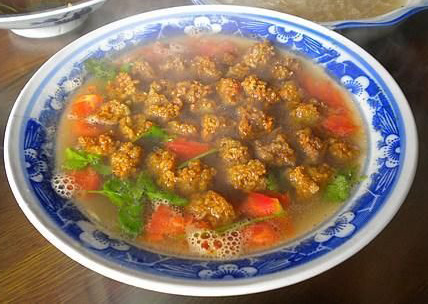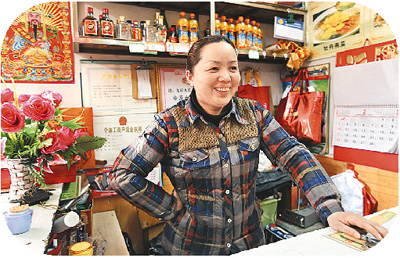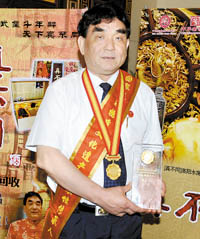-
沒有記錄!
洛陽水席
2011/3/21 9:26:08 點擊數: 【字體:大 中 小】
到洛陽的時候已不是花季,見不到牡丹滿城國色天香,不免有些遺憾,還好還有可以吃的非物質文化遺產——水席,以及那一道讓人驚艷的“牡丹燕菜”。
那菜上來極是典雅隆重:盤底鋪陳著五色的菜絲,中間是一朵雞蛋糕雕的牡丹花,澆上湯后,花便漂浮在上面。而分盛給每人的小碗中也同樣有一朵小小的牡丹花。這要追溯到1973年了,當時周恩來總理陪同加拿大總理特魯多來洛游覽,廚師們用雞蛋糕精心雕刻了一朵牡丹花放在燕菜上。周總理風趣地稱贊:“洛陽牡丹甲天下,菜中也能生出牡丹花!”從此,“洛陽燕菜”便被人們喚作“牡丹燕菜”了。
貴為水席的頭道大菜,牡丹燕菜的主料卻是最最平常的白蘿卜。很多人是怕吃白蘿卜的,便不敢動筷,只是看著眼前那精致的一小碗發呆,直到旁邊的人說“ 完全沒有蘿卜味兒!”吃光了自己碗里的不算,還要再添一兩碗。 這不需要客氣,當年女皇帝武則天吃到這“蘿卜絲湯”時,也是大為贊賞,并以其具有燕窩風味賜名“假燕菜”。
水席的特色是菜品湯湯水水,上菜行云流水,與武則天的民間傳說淵源很深。全席依序分為前八品、四鎮桌、八中件、四掃尾,共 24道菜,預示了武則天執政24年。 前八品為冷盤,以武則天的八大善績——服、 禮、 韜、欲、藝、文、禪、政為名。接著上四個大菜,每上一個大菜,帶兩個中菜,稱為“帶子上朝”。
去年 6月 14 日,國務院發布第二批國家級非物質文化遺產名錄,已有百余年歷史的中華老字號飯店“真不同”的洛陽水席制作技藝入選,這也是目前全國餐飲業唯一的全套宴席入選國家級非物質文化遺產。
自古以來,游龍門、賞牡丹、品水席就被稱為洛陽三絕,在民間更有“不進真不同,未到洛陽城”之說。在認真研習歷史文獻的基礎上,“真不同” 還將洛陽水席融入了盛唐文化、 官場文化、民間文化、民俗文化、戲曲文化及趣味化等諸多元素。
水席可大可小、豐儉隨己。在傳統名店,可以選擇花費數百元甚至幾千元上全24 道菜的全席,也可以選擇專門為人數較少的游客推出的小型經典組合,再隨意些,街頭巷尾的小型水席店,點上幾道代表菜色,人均不過幾十元就能吃得很好。
看著大大小小生意興隆的水席店,不由想起近年來起起伏伏的魯菜。魯菜是“北食”的代表,中國四大菜系之一。如何挖掘魯菜悠久的歷史文化底蘊,適應現代市場需求,包裝策劃出與市場直接對接的產品,洛陽水席或可為鑒。
Luoyang Shuixi
If you don’t taste Luoyang Shuixi, which is an intangible heritage, besides appreciating peonies when you come to Luoyang, it will be a great pity. Among the Shuixi, the most tempting one is Peony Cubilose. This dish is made very dedicate: lay colorful vegetable shreds on the bottom, a delicate peony in the middle which is carved by cakes. The peony will float on the soup in every bowl. This can date back to 1973, when Premier Zhou was in company with the prime minister of Canada to Luoyang, Premier Zhou praised that: the peony is the best in the world, even dishes can grow out peonies. And from then on, there is always a peony in the middle of bowl and it’s also called Peony Cubilose.
However, as the first main course in Shuixi, the main material is white radish. Many people hate to eat radish, while, it tastes not like rabbit at all. In Chinese history, the only female Emperor, Wu Zetian, granted it Artifical Cubilose when she ate this sliced radish soup out of this reason.
The biggest characteristics are almost all the dishes contain soup and the dishes are brought one by one in a linear sequence. Shuixi is composed of 24 courses which are deep influenced by the legend of Wu Zetian and the 24 courses stand for Wu’s 24 regional years.
In 14th, June, 2011, the making skill of Luoyang Shuixi in Zhenbutong Restaurant, which has been established for at least 100 years, is listed into the Second Intangible National Heritage by the State Department. This is the first whole feast chose as intangible national heritage in China. Studying various documents, Zhenbutong Restaurant combines the flourishing Tang Dynasty culture, official circles culture, folk culture, Chinese opera culture and interest culture into Luoyang Shuixi and develops it into one of the three biggest unique in Luoyang together with the Longmen Grottoes and Luoyang peony. Nowadays, Shuixi is changeable. People can choose the whole feast in traditional restaurants, or choose just several courses among them depending on personal taste in some smaller restaurant.






